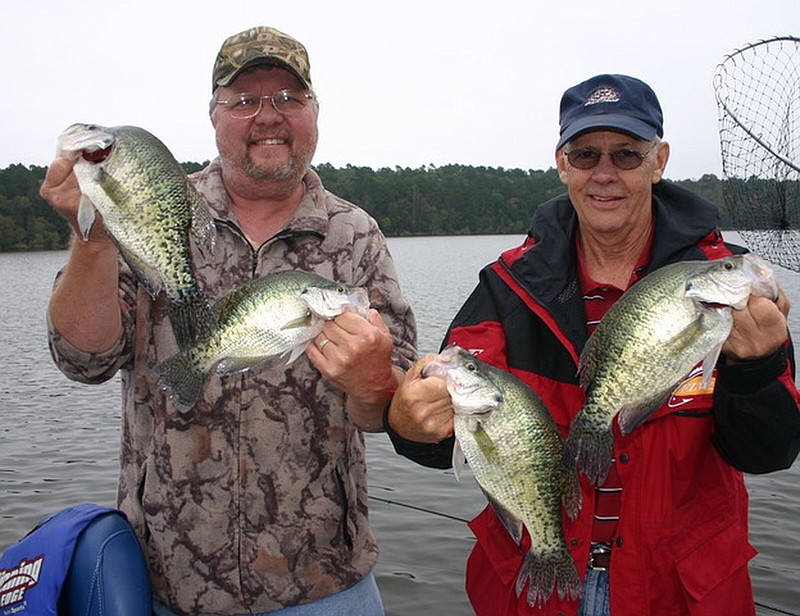We hear a lot about our most popular crappie lakes, but many lesser known lakes in Arkansas offer top-notch crappie fishing, as well.
Depending on location, crappie will begin their pre-spawn activities in late February through early March. They will move to the banks to spawn in mid March through April, and that's when they are easiest to find and catch.
The mainstream popularity of forward-facing sonar has changed crappie fishing permanently. Traditional tactics like spider rigging, trolling and bobbing minnows at variable depths over brushpiles still work, but forward-facing sonar saves anglers time and effort by eliminating cover that doesn't hold fish.
Now, the adventure is finding new places to use it. We give you a roster of small, remote, obscure lakes that are the perfect size for fishing from boats or kayaks.
LAKE FORT SMITH
Because Beaver Lake so dominates the Northwest Arkansas fishing culture, anglers overlook a lot of smaller lakes in the region that offer excellent crappie fishing. One of our favorites is Lake Fort Smith near Mountainburg.
The signature feature of Lake Fort Smith State Park, the lake covers 1,390 surface acres. The lake contains a lot of wide flats that drop into the Frog Bayou channel. In the fall and winter, crappie concentrate on bends in the channel. I've caught some big ones in the upper end of what used to be Lake Shepherd Springs trolling crankbaits upstream against the wind.
My experience shows that big crappie stack in the deep water of the bends, and each pass produces at least one hefty slab measuring 14-15 inches. They hit light, and every bite came while trolling upstream. That's an old-school tactic. A forward-facing sonar would allow you to position over a school of crappie and probably increase your catch rates.
LAKE GILLHAM
Covering 1,370 surface acres in Howard County, Lake Gillham is almost identical in size to Lake Fort Smith.
Impounding the Cossatot River below its whitetwater section, Lake Gillham has an average depth of 20 feet and a maximum depth of 90 feet. Average water clarity is about 3 feet.
Lake Gillham has an assortment of flats, humps and points. In the winter, crappie congregate on structure near channels at depths of 15-25 feet. The lake does not have a high-density crappie population, but avid crappie anglers say it has exceptionally large crappie.
In winter, smallmouth bass from the Cossatot River move into Lake Gillham. As a bonus, you can catch them in the upper end near the river mouth.
DIERKS LAKE
The late Bill Rhodes of Sheridan turned me on to the great crappie fishing at Dierks Lake, an impoundment of the Saline River in Howard County. Rhodes and his wife Kay used to camp at Dierks Lake for weeks and fill their freezer with crappie fillets.
At 1,360 acres, Dierks Lake it's also about the same size as the aforementioned lakes. Its best known areas for crappie are Blue Ridge, Horseshoe and Maguire, the latter two being oxbows off the main river. There you will find 20-foot water containing a lot of structure. A LiveScope will tell you immediately if crappie are home.
LAKE HINKLE
This 960-acre gem in the heart of the Ouachita National Forest near Waldron is a sleeper. It's hard to reach and hard to fish, but like the other lakes, it has some very large crappie.
A Waldron crappie enthusiast introduced me to Lake Hinkle many years ago. We caught a box full of slabs "dead-sticking" gray jigs with mylar hackle against visible timber.
There is a lot of structure on this lake, including an old farm pond whose levees are still standing. This is almost always a great place to find crappie, especially after a few warm days heats the water a few degrees and spurs them to leave their deep haunts nearby. Again, LiveScope will help you find fish and isolate productive structure a lot quicker.
A few years ago, the Arkansas Game and Fish Commission treated the lake with lime. This energized the food chain, and game fish are still reaping the benefits.
Lake Hinkle is one of those rare places where just being there is worth the drive whether you catch fish or not. It's in my top five most beautiful places in Arkansas.
LAKE GREESON
A scenic, 2,500-acre impoundment of the Little Missouri River near Murfreesboro, Lake Greeson has more than 1,000 brushpiles and "crappie condos," which are large bamboo arrangements set with concrete in 5-gallon buckets.
Right now, crappie are most likely to be on structure that's 25-35 feet deep, again near major and secondary channels. The best brush piles are at 25-35 feet with 60- to 70-foot water close, and with 90-foot water nearby. A traditionally productive method was to drift live minnows over a brush pile at different depths. When a fish hits, make note of the depth to which the bait on that rod is set. If it's consistent, then you can set other rods to that depth. Unless you just enjoy fishing that way, LiveScope makes it a lot easier.
REFUGE LAKES
Crappie fishermen have access to thousands of acres of small, remote lakes in the Cache River and White River national wildlife refuges in southeast Arkansas. They're shallow oxbows mostly, and while "deep" water might only be two or three feet below the average depth, that's still where you'll find crappie this month.
In cold weather, you can catch crappie by slow-trolling spider rigs in the middle of the lakes. A spider rig holds three to five rods and attaches to the bow of the boat.
Spider rigging requires heavier jigs than those used for the cast-and-countdown method. Use ¼-ounce jigs in depths of 6-10 feet. If the water is dingy, try yellow/white or blue/white. Chartreuse is good in clear water. Light line, 4- to 8-pound, is best. Always troll against the wind, just as we did at Lake Shepherd Springs.
